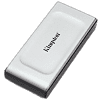 10
10
Kingston XS2000 2 TB Review - World's Smallest and Fastest Portable SSD
(10 Comments) »Introduction

With revenue in the multi-billion dollars, Kingston is the largest DRAM and flash memory products vendor in the world. While their strongest suit is in memory modules and USB/flash card storage, they are also a major player in the SSD market, which, besides internal storage, includes portable SSDs, too.

Today, we bring you a review of the Kingston XS2000, which is the company's new flagship portable SSD. It utilizes the blazing-fast USB 3.2 Gen 2x2 20 Gbps interface, which doubles transfer rates over USB 3.2 Gen 2x1, aka USB 3.1 Gen 2. Many portable SSDs using USB 3.2 Gen 2x1 were bottlenecked by the USB interface speed, which has taking interface transfer rates to the next level make sense. At this time, only four AMD AM4 motherboards natively support the 20 Gbps USB interface; on Intel, there's about 70 motherboards, most using the Z590 chipset. For all our testing, we used a Gigabyte GC-USB 3.2 Gen2x2 PCI-Express x4 add-in card, so we can properly max out Kingston's new XS2000 portable SSD.
Internally, the XS2000 uses a Silicon Motion SM2320 controller, a new design with USB bridge chip and SSD controller in a single processor, which not only reduces space requirements, but is also cheaper and lowers the design complexity significantly. The XS2000 uses 3D TLC NAND flash, a DRAM cache chip is not installed.
We review the Kingston XS2000 in the 2 TB variant, which retails for $300, but it is also available in capacities of 500 GB and 1 TB. The warranty is set to five years for all these models.
Package
The Drive
The Kingston XS2000 is really compact, much smaller than most other external SSDs we've tested so far.
The outer shell of the XS2000 is made out of plastic. Kingston combined black with silvery highlights to create the impression of a metal case.
Also included in the package is a rubber sleeve, which is required to achieve the IP55 resistance rating. The first "5" in IP55 stands for "dust protected"—"Ingress of dust is not entirely prevented, but it must not enter in sufficient quantity to interfere with the satisfactory operation of the equipment." No surprise there, dust really doesn't affect the operation of an SSD anyway. The second "5" stands for "Water jets"—"Water projected by a nozzle (6.3 mm (0.25 in)) against enclosure from any direction shall have no harmful effects." This one is more interesting, but not a big surprise considering the rubber sleeve is required for such protection in the first place.
Internally, the drive doesn't have any liquid protection, no seals or rubber gaskets.
A single USB-C port lets you connect to the drive. A blue activity indicator is located right next to the USB-C port.
Our Patreon Silver Supporters can read articles in single-page format.
May 4th, 2025 16:32 EDT
change timezone
Latest GPU Drivers
New Forum Posts
- Question about photos (2)
- which cooler CPU is better? (10)
- Vertical mice in gaming (6)
- PSU chirping sound (12)
- RX 9000 series GPU Owners Club (631)
- I got a new motherboard about to start a DTS journey (1)
- Thread '(thread name)' could use more distinction (3)
- Windows 11 General Discussion (6019)
- ASRock Z590 OC Formula. (33)
- Subsystem Id of my Asus Strix RTX 4090 OC / Random GPU detection problem (32)
Popular Reviews
- Clair Obscur: Expedition 33 Performance Benchmark Review - 33 GPUs Tested
- ASUS ROG Maximus Z890 Hero Review
- ASUS Radeon RX 9070 XT TUF OC Review
- Montech HS02 PRO Review
- NVIDIA GeForce RTX 5060 Ti 8 GB Review - So Many Compromises
- ASUS GeForce RTX 5090 Astral Liquid OC Review - The Most Expensive GPU I've Ever Tested
- Seasonic Vertex GX 850 W Review
- Upcoming Hardware Launches 2025 (Updated Apr 2025)
- ASRock Radeon RX 9070 XT Taichi OC Review - Excellent Cooling
- Sapphire Radeon RX 9070 XT Nitro+ Review - Beating NVIDIA
Controversial News Posts
- AMD Radeon RX 9060 XT to Roll Out 8 GB GDDR6 Edition, Despite Rumors (129)
- NVIDIA Sends MSRP Numbers to Partners: GeForce RTX 5060 Ti 8 GB at $379, RTX 5060 Ti 16 GB at $429 (128)
- NVIDIA Launches GeForce RTX 5060 Series, Beginning with RTX 5060 Ti This Week (115)
- Nintendo Confirms That Switch 2 Joy-Cons Will Not Utilize Hall Effect Stick Technology (105)
- NVIDIA PhysX and Flow Made Fully Open-Source (95)
- Sony Increases the PS5 Pricing in EMEA and ANZ by Around 25 Percent (84)
- Parts of NVIDIA GeForce RTX 50 Series GPU PCB Reach Over 100°C: Report (78)
- Intel "Bartlett Lake-S" Gaming CPU is Possible, More Hints Appear for a 12 P-Core SKU (77)









